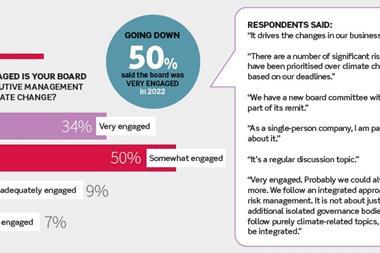New research shows risk managers are more concerned about extreme weather than any other threat to operations. Despite this a quarter of firms have no plans to mitigate climate risks. Here are five ways to protect your organisation
For the first time, businesses are more concerned about extreme weather affecting operations in 2030 than they are about cyber-attacks.
Extreme weather events have now surpassed threats to IT infrastructure as the top operational risk, according to a new survey from global risk management provider, Healix.

The research which asked respondents to look at the risks they are most concerned about, identified extreme weather (43%), cyber-attacks (40%), and interstate Conflict (38%) as the top three biggest concerns.
The European risk landscape in 2024
- Survey respondents said the top three risks facing Europe in 2024 are macroeconomic risk (52%), energy supply (51%), and the Russia-Ukraine conflict (46%)
James Towndrow, regional intelligence analyst (ECIS) at Healix says: ”The Russian invasion of Ukraine, adding to the residual impacts of the Covid-19 pandemic, is the main driver underlying the risks facing organisations across Europe.
”High energy prices and slowed economic growth, traceable to the conflict, demonstrate the capacity for major geopolitical risk factors to disrupt global supply chains and impact consumer spending.
”Widespread economic and political impacts associated with the conflict have forced governments to adopt tighter monetary policies, in turn prompting the reconsideration of existing climate goals.
”High inflation slowed economic growth, and the increase in interest rates as a result of wider geopolitical risk factors is likely to undermine investor confidence. Impacts are likely to be felt in sectors including manufacturing and construction.
”The current trajectory of fighting in Ukraine points to a protracted conflict. European sanctions against Russia have dented but failed to derail the Russian economy, with the Kremlin orientating spending with a view to sustaining military operations in Ukraine well into 2024 and likely beyond.
”Domestic governments are likely to orientate policy towards navigating further economic turbulence over the coming winter. Concerns regarding supply drops in the availability of Russian natural gas, increased global demand for liquefied natural gas (LNG) and the possibility of more severe winter conditions in Europe add to continued uncertainty ahead of the upcoming winter.”
What does it mean for risk managers and businesses?
Not only are risk managers concerned about extreme weather, but almost three-quarters (73%) of businesses say they have already been directly affected by it.
The highest impacted industry is manufacturing (86%) where operations are widely dispersed among physical environments and geographies. The media industry also ranked high (83%), accounting for the risks involved in reporting on these extreme weather events on location.
Of all the extreme weather events, businesses were most concerned about extreme heat affecting employees (41%), followed by heavy rainfall and flooding (37%) and wildfires (33%).
This makes sense because not only can extreme heat affect personnel with medical risks such as heatstroke and severe dehydration as a standalone factor, but it can also lead to associated factors related to extreme heat, such as wildfires.
”It is concerning to see so many respondents with no plan in place to manage climate-related risk.”
Andrew Devereux, risk intelligence manager at Healix, says, “With consistent reports of wildfires and flooding over the last 12 months, from the wildfires of Hawaii and Canada, to the 50-degree Celsius temperatures in South America and the flooding in China, it comes as no surprise that our survey shows businesses are most concerned about the impact of extreme weather.
“As a global trend, the common theme of all climate-related risks is that they are indiscriminate and lead to tangible risks, whether it’s physical risks to staff or operational risks such as security of infrastructure and supply chain.”
When asked about the risks that would have the most impact on operations, natural disasters came out highest (34%) ahead of societal/cultural (30%). Despite this, a quarter (25%) of respondents said they had no plan in place to mitigate risks around Climate or Sustainability.
Andrew Devereux concludes, “It is concerning to see so many respondents with no plan in place to manage climate-related risk. What used to be latent and perceived as a longer-term risk, must now become part of business continuity plans.
“The hard truth is that we’re experiencing more immediate physical and direct operational impact from changing climate patterns. It is crucial that businesses think about climate risk in the same short-term view they have for cultural or societal risk, such as political unrest.”
How to tackle the threats
Healix identifies five steps organisations must take to mitigate climate, nat cat and weather-related threats:
1) Monitor the risk environment
Relevant, corroborated and up-to-date information plays a key part in effective risk identification. Stay abreast of the latest developments using data from multiple reliable sources, and be wary of misinformation. External suppliers or embedded analysts can be valuable for managing the collection and analysis of intelligence, identifying new or evolving risks, and monitoring long-term trends on your behalf, where you may lack the in-house resource.
2) Prepare with crisis management planning & training
This should involve forecasting potential crises specific to your organisation and developing plans around how to deal with them. The process includes the identification of the characteristics of a crisis and subsequent intervention in order to minimise reputational, financial, operational or legal risks and facilitate recovery.
3) Get ahead of location-specific risks by planning your evacuation and emergency responses
It is essential to develop comprehensive plans to extract your staff from challenging operating environments. Your plan should look at your staff exposure, infrastructure, routes, ports of departure, operational issues, and the escalation point ‘triggers’ that signal a deterioration in the specific environment.
4) Ensure robust planning around staff travel
Leveraging ground support and protective services ensures the safety of your staff, executives and loved ones to enable them to travel with confidence. It is important to assess the threat and risk environment, and find solutions in an individualised security plan, scaled to accommodate your different environments and risk appetites.
5) Take steps towards mitigating personalised risks
Building a personalised risk profile requires a strong bond of trust between business and traveller. In order to make sure risk profiles are robust and effective, businesses must find honest and transparent ways to gather sensitive personal information from employees, while making every effort to keep that information secure and prevent it from falling into the wrong hands. This process, while complex, is crucial to ensuring that each traveller is equipped with the knowledge and resources they need to navigate their own unique risk experience.




















No comments yet